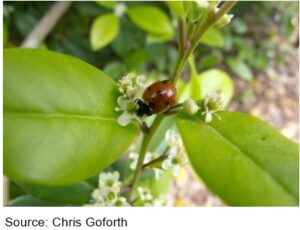Standards + Practices

DCI: LS2.A Interdependent relationships in ecosystems
ESS3.C Human impacts on earth systems
SP6: Constructing Explanations
As students speculate on ways to improve their school grounds, they construct explanations that are supported with evidence using the data collected and analyzed this year.
SP2: Developing and Using Models
Students continue to use their School Grounds Map as a model and consider how proposed improvements may impact how the system functions. Students revise the model to represent a system that attracts ladybugs.
SP1: Asking Questions & Defining Problems
Students revisit their School Grounds Map, posing questions about their observations and identifying areas in need of improvement.
Resources + Supports

Ms. Jones’ Class Compares Ecosystems, Habitats, and Microhabitats
After teaching about common ecosystems (e.g., oceans, lakes, forests, salt marshes) earlier in the year, Ms. Jones notices that her students interchange the terms ecosystem and habitat. She would like to help students understand the difference between the two and that habitats vary in size based on the organism. She plays a short video explaining the difference between the terms and introduces the range of habitat sizes by contrasting a Black bear’s range of roughly 60 square miles with a frog who lives within a small pond. Ms. Jones directs students’ attention to the “location” section of their recording sheet for the Ladybugs at School Project and asks what they notice. Although students have been recording these data throughout the year, they had not considered the specificity and the importance of these small habitats, often referred to as “microhabitats” by scientists. Ms. Jones refers students back to their School Grounds Map and asks students to consider what would happen if the bush outside their classroom where they’ve found several ladybugs were removed. Students express concern over this idea, recognizing that aphids and other insects would not have the bush to feed on, and therefore, ladybugs would not have those insects to eat. Ms. Jones then asks students what could be added to their school grounds that could likely serve as a microhabitat for ladybugs and gives students time to generate ideas with a partner. Once students list ideas, Ms. Jones challenges them to support their ideas for habitat improvements with data they have collected. Ms. Jones provides the following example: “I think we could add more flowering plants near the back entrance of our school, because we found several ladybugs on flowers planted near the front entrance at the beginning of the school year. We only found one near the back entrance of our school even though we looked there five times in the first couple months of school.”

Practice Overview: Constructing Explanations
Students have focused on examining patterns in ladybug sightings (or lack thereof) on their school grounds. This month, the focus shifts to applying what they have learned to make recommendations for improving habitat.
Students will use data from multiple sources (own data sheets, Ladybugs at School project data available through iNaturalist, School Grounds Map) to construct explanations of what attracts ladybugs to a particular habitat. As students analyze and interpret the data, they should be thinking about how they will use their data as evidence to describe what attracts ladybugs. Support students in distinguishing between relevant and irrelevant data as they construct explanations. For example, focusing on the weather data collected on the data collection sheet is valuable information to consider during analysis but irrelevant to the focus of this explanation. On the other hand, identifying similar features of microhabitats where ladybugs are consistently found throughout the school year would support this explanation. Here are some questions that may help students analyze and interpret their data:
- Did we have any ladybug sightings where multiple ladybugs were found in one location at one time?
- What notes do we have from that sighting to help us understand what may have attracted the ladybugs to that location at that time?
- Are there any locations where we found ladybugs multiple times throughout the school year?
- If so, what are some of the features of that location that may have attracted ladybugs?
Whenever students make a claim about something that attracts ladybugs, encourage them to use their data from ladybug sightings to support the claim. Model this process for students by working as a class to construct explanations related to the overarching scientific questions:
- How does the presence of ladybugs change across the school year? What might explain those changes?
- Which species of ladybugs do we find at our school? Are they native, non-native, or both?
- What features of our school grounds make the space habitable/uninhabitable for native ladybugs?
- How can we improve habitat for ladybugs in our schoolyard?
See Assessment Writing Prompt support below to provide students’ with an opportunity to construct their own explanation.

Writing Prompt
We are hoping to observe more ladybugs on our school grounds next year. What recommendations do you have about possible changes we could make to attract and improve habitat for ladybugs in our school yard? Use data you have collected as evidence to support your recommendations.
Prompts to help students as they construct explanations:
- What types of recommendations would make sense? (For example, recommendations regarding factors beyond human control such as changing outdoor temperatures are unreasonable.)
- What attracts ladybugs?
- How do the data collected provide evidence for this idea?
- What is a change we could make to the school grounds that would use this attraction?
- How does the ladybug’s role in the food web impact where you may find it?
- How does the data collected provide evidence for this idea?
- Ladybugs are consumers. Where would you expect to find ladybug prey?
- What change could we make to the school grounds that would attract ladybugs based on what we know about them as predators or as prey?
Check student responses for the following:
- Students identify at least two recommendations for changing and/or maintaining school grounds in a particular way to attract more ladybugs.
- Students use specific data as evidence to support each recommendation.
- The data used as evidence is explained in relation to the recommendation.

In next month’s activities, students will be presenting their findings to an authentic audience. Brainstorming with students to determine your audience prior to next month may be helpful in scheduling a date for your presentations. Ideas for an authentic audience can be found in next month’s Literacy Content support.


